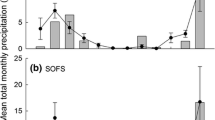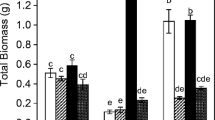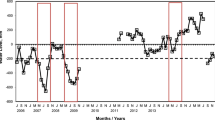Abstract
Nutrient availability strongly affects the species composition and productivity of most upland ecosystems, but the importance of nutrient availability is largely undefined for riparian ecosystems in semiarid regions of the western United States. The establishment and persistence of riparian cottonwood (Populus spp.) seedlings depends largely on water availability, but this does not preclude an important role for nutrient availability. To investigate how nitrogen availability may influence the composition and productivity of riparian communities, we tested the hypothesis that the growth and survival of first-year Fremont cottonwood seedlings is limited by the availability of both water and nitrogen. Plots of naturally germinated cottonwood seedlings along the Yampa River in Northwest Colorado were randomly assigned one of four treatments: control, water, nitrogen, or water plus nitrogen. Additions of nitrogen or water doubled total (root plus shoot) seedling and shoot length. Water additions did not increase root growth, while N addition doubled the root extension of first-year cottonwood seedlings. The water-plus-nitrogen treatment doubled total seedling and root length, and tripled shoot length. Additions of water or nitrogen also more then doubled cottonwood seedling survival through the first growing season. This co-limitation of cottonwood germinants by both water and nitrogen suggests that the productivity and species composition of riparian vegetation may need to be examined in relation to supplies of resources other than water.
Similar content being viewed by others
Literature cited
Aber, J. D. and J. M. Melillo. 1991. Terrestrial Ecosystems. Saunders College Publishing, Orlando, FL, USA.
Begg, C. S., O. W. Archibold, and L. Delanoy. 1998. Preliminary investigation into the effects of water-level control on seedling recruitment in riparian cottonwoods, Populus deltoides, on the South Saskatchewan River. Canadian Field-Naturalist 112:684–693.
Braatne, J. H., S. B. Rood, and P. E. Heilman. 1996. Life history, ecology, and conservation of riparian cottonwoods in North America. p. 57–85. In R. F. Stettler, H. D. Bradshaw, P. E. Heilman, and R. M. Hinckley (eds.) Biology of Populus and Its Implications for Management and Conservation. NRC Research Press. Ottawa. Ontario, Canada.
Chapin, F. S. 1993. Physiological controls over plant establishment in primary succession. p. 161–178. In J. Miles and D. W. H. Walton (eds.) Primary Succession on Land. Blackwell Scientific Publication, Oxford, England.
Cooper, D. J., D. M. Merritt, D. C. Andersen, and R. A. Chimner. 1999. Factors controlling the establishment of Fremont cotton-wood seedlings on the Upper Green River, USA. Regulated Rivers—Research & Management 15:419–440.
Heil, G. W. and W. H. Diemont. 1983. Raised nutrient levels change heathland into grassland. Vegetatio 53:113–120.
Hooper, D. U. and L. Johnson. 1999. Nitrogen limitation in dryland ecosystems: responses to geographical and temporal variation in precipitation. Biogeochemistry 46:247–293.
Johnson, W. C. 1992. Dams and riparian forests: case study from the Upper Missouri River. Rivers 3:229–242.
Lauenroth, W. K., J. L. Dodd, and P. L. Sims. 1978. Effects of water induced and nitrogen induced stresses on plant community structure in a semi-arid grassland. Oecologia 36:211–222.
Liebig, J. V. 1840. Die Organische Chemie in Ihrer Anwendung Auf Agricultur Und Physiologie (Organic Chemistry in Its Applications to Agriculture and Physiology). Friedrich Vieweg und Sohn Publishing Co., Braunschweig, Germany.
Merritt, D. M. and D. J. Cooper. 2000. Riparian vegetation and channel change in response to river regulation: a comparative study of regulated and unregulated streams in the Green River Basin, USA. Regulated Rivers—Research & Management 16: 543–564.
Noy-Meir, I. 1973. Desert ecosystems: environment and producers. Annual Review of Ecology and Systematics 4:25–51.
Pallardy, S. G. and T. T. Kozlowski. 1979. Early root and shoot growth of Populus clones. Silvae Genetica 28:153–156.
Pregitzer, K. S. and A. L. Friend. 1996. The structure and function of Populus root systems. In The Biology of Populus. Stettler, RF, HD Bradshaw, PE Heilman, and TM Hinkley (eds). NRC Research Press, Ottawa.
Poff, N. L., J. D. Allan, M. B. Bain, J. R. Karr, K. L. Prestegaard, B. D. Richter, R. E. Sparks, and J. C. Stromberg. 1997. The natural flow regime. Bioscience 47:769–784.
Sala, O. E., W. J. Parton, L. A. Joyce, and W. K. Lauenroth. 1988. Primary production of the Central Grassland Region of the United States. Ecology 69:40–45.
Scott, M. L., G. T. Auble, and J. M. Friedman. 1997. Flood dependency of cottonwood establishment along the Missouri River, Montana, USA. Ecological Applications 7:677–690.
Scott, M. L., J. M. Friedman, and G. T. Auble. 1996. Fluvial process and the establishment of bottomland trees. Geomorphology 14: 327–339.
Seastedt, T. R. and A. K. Knapp. 1993. Consequences of nonequilibrium resource availability across multiple time scales—the transient maxima hypothesis. American Naturalist 141:621–633.
Segelquist, C. A., M. L. Scott, and G. T. Auble. 1993. Establishment of Populus deltoides under simulated alluvial groundwater declines. American Midland Naturalist 130:274–285.
Smith, S. D., D. A. Devitt, A. Sala, J. R. Cleverly, and D. E. Busch. 1998. Water relations of riparian plants from warm desert regions. Wetlands 18:687–696.
Sprengel, C. 1828. Von Den Substanzen Der Ackerkrume Und Des Untergrundes (About the Substances in the Plow Layer and the Subsoil). Journal für Technische and Okonomische Chemie 2 and 3:423–444, 42–99, 313–352, 397–421.
Taylor, J. P., D. B. Wester, and L. M. Smith. 1999. Soil disturbance, flood management, and riparian woody, plant establishment in the Rio Grande floodplain. Wetlands 19:372–382.
Tilman, D. 1987. Secondary succession and the pattern of plant dominance along experimental nitrogen gradients. Ecological Monographs 57:189–214.
United States Geological Survey. 2000. Water quality data for Colorado, U.S.A. http://water.usgs.gov/co/nwis/qw.
Vitousek, P. M., J. D. Aber, R. W. Howarth, G. E. Likens, P. A. Matson, D. W. Schindler, W. H. Schlesinger, and D. G. Tilman. 1997. Human alteration of the global nitrogen cycle: sources and consequences. Ecological Applications 7:737–750.
Wedin, D. A. and D. Tilman. 1996. Influence of nitrogen loading and species composition on the carbon balance of grasslands. Science 274:1720–17.
Author information
Authors and Affiliations
Rights and permissions
About this article
Cite this article
Adair, E.C., Binkley, D. Co-limitation of first year Fremont cottonwood seedlings by nitrogen and water. Wetlands 22, 425–429 (2002). https://doi.org/10.1672/0277-5212(2002)022[0425:CLOFYF]2.0.CO;2
Received:
Revised:
Accepted:
Issue Date:
DOI: https://doi.org/10.1672/0277-5212(2002)022[0425:CLOFYF]2.0.CO;2




